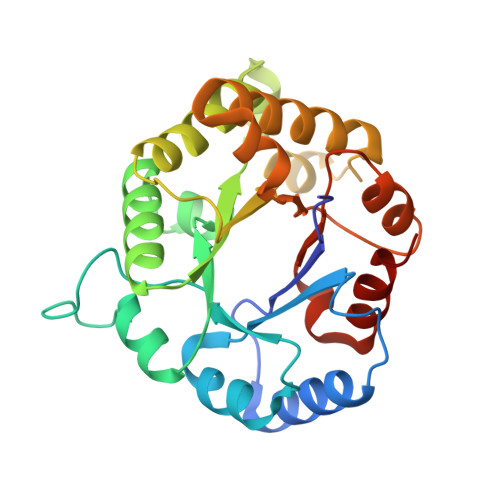Structural basis for the modulation of plant cytosolic triosephosphate isomerase activity by mimicry of redox-based modifications.
Castro-Torres, E., Jimenez-Sandoval, P., Romero-Romero, S., Fuentes-Pascacio, A., Lopez-Castillo, L.M., Diaz-Quezada, C., Fernandez-Velasco, D.A., Torres-Larios, A., Brieba, L.G.(2019) Plant J 99: 950-964
- PubMed: 31034710
- DOI: https://doi.org/10.1111/tpj.14375
- Primary Citation of Related Structures:
6NXQ, 6NXR, 6NXS, 6NXW, 6NXX, 6NXY - PubMed Abstract:
Reactive oxidative species (ROS) and S-glutathionylation modulate the activity of plant cytosolic triosephosphate isomerases (cTPI). Arabidopsis thaliana cTPI (AtcTPI) is subject of redox regulation at two reactive cysteines that function as thiol switches. Here we investigate the role of these residues, AtcTPI-Cys13 and At-Cys218, by substituting them with aspartic acid that mimics the irreversible oxidation of cysteine to sulfinic acid and with amino acids that mimic thiol conjugation. Crystallographic studies show that mimicking AtcTPI-Cys13 oxidation promotes the formation of inactive monomers by reposition residue Phe75 of the neighboring subunit, into a conformation that destabilizes the dimer interface. Mutations in residue AtcTPI-Cys218 to Asp, Lys, or Tyr generate TPI variants with a decreased enzymatic activity by creating structural modifications in two loops (loop 7 and loop 6) whose integrity is necessary to assemble the active site. In contrast with mutations in residue AtcTPI-Cys13, mutations in AtcTPI-Cys218 do not alter the dimeric nature of AtcTPI. Therefore, modifications of residues AtcTPI-Cys13 and AtcTPI-Cys218 modulate AtcTPI activity by inducing the formation of inactive monomers and by altering the active site of the dimeric enzyme, respectively. The identity of residue AtcTPI-Cys218 is conserved in the majority of plant cytosolic TPIs, this conservation and its solvent-exposed localization make it the most probable target for TPI regulation upon oxidative damage by reactive oxygen species. Our data reveal the structural mechanisms by which S-glutathionylation protects AtcTPI from irreversible chemical modifications and re-routes carbon metabolism to the pentose phosphate pathway to decrease oxidative stress.
Organizational Affiliation:
Laboratorio Nacional de Genómica para la Biodiversidad, Centro de Investigación y de Estudios Avanzados del IPN, Apartado Postal 629, Irapuato, Guanajuato, México, CP 36821, México.














